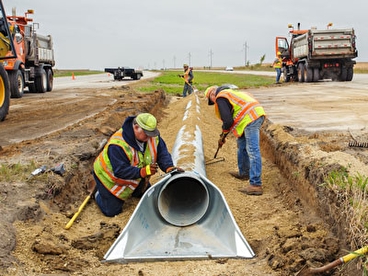Culvert Installation Facilitated: Step-by-Step Guide for Success
From picking the ideal culvert dimension to integrating correct water drainage steps, each step in the installation process plays a critical role in the performance and longevity of the culvert system. Stay tuned to discover the essential actions and considerations that can make culvert setup a smooth and effective endeavor.
Choosing the Right Culvert Size
Selecting the appropriate culvert dimension is critical for making sure reliable water circulation and structural integrity in culvert setup jobs - Pad Construction. The size of the culvert straight impacts the flow ability of water via the framework. A culvert that is too little can result in flooding and overflow, while one that is as well huge might lead to decreased water rate, possibly triggering sediment build-up and obstructions
To establish the best culvert size, aspects such as the watershed area, top circulation prices, and hydraulic effectiveness requirement to be thoroughly considered. Calculations based on these criteria aid in picking a dimension that can properly manage the anticipated water volume while decreasing the danger of clogs and architectural failure.
It is vital to get in touch with design guidelines and standards to ensure that the selected culvert dimension meets the job requirements and regional guidelines (Pad Construction). By choosing the right culvert dimension, project managers can optimize water circulation, protect against possible concerns, and enhance the overall efficiency and durability of the culvert installment
Preparing the Installation Website
Efficient culvert installation requires thorough prep work of the setup website to guarantee optimum structural support and functionality. Prior to beginning the installment process, it is vital to clear the site of any type of particles, greenery, or blockages that can restrain the culvert's placement. Making sure a degree structure is essential for the proper alignment and security of the culvert. This may involve rating the site to produce a smooth, even surface area that can sufficiently sustain the weight of the culvert and any expected lots. In addition, appropriate compaction of the dirt under the culvert is essential to avoid clearing up or shifting with time.
In addition, it is crucial to take into consideration variables such as dirt structure, groundwater degrees, and ecological impacts when preparing the installation site. Performing a thorough website analysis can help identify any kind of possible difficulties or threats that might affect the culvert's performance. By making the effort to prepare the installation site properly, you can aid assure a successful culvert setup that fulfills architectural needs and this website makes sure lasting capability.
Positioning the Culvert Correctly

The quality at which read review the culvert is positioned is vital for keeping an appropriate slope for water circulation. A gradual slope assists prevent pooling and advertises effective water drainage. Additionally, the culvert should be oriented properly to guarantee that the inlet and electrical outlet remain in the proper areas. This positioning is essential for the culvert to work effectively in taking care of water flow.
Backfilling and Compacting the Dirt
Correct backfilling and compaction of the soil around the culvert is necessary to make certain security and protect against prospective concerns in the future. When the culvert is properly placed, the next important action is to backfill the location around it with ideal product.
After positioning the backfill material, it is necessary to portable it in layers of consistent density. Making use of a compactor or a mechanical meddle, small the soil carefully to prevent harming the culvert. Compaction aids in lowering the opportunities of settlement and makes sure consistent support around the culvert. It is essential to compact the soil uniformly on all sides of the culvert to maintain its structural stability.
Appropriate backfilling and compaction not only provide stability to the culvert however also help in avoiding dirt erosion and maintaining the long life of the culvert system.
Making Sure Appropriate Drainage Assimilation
Integrating efficient water drainage remedies plays a critical duty in the total capability and longevity of culvert installments. Correct drain assimilation is essential for handling water circulation, preventing erosion, and making certain the architectural stability of the culvert system. To accomplish this, it is crucial to create an extensive drainage plan that takes into consideration elements such as the quantity of water expected, the topography of the location, and the kind of dirt existing.

In addition, including features like disintegration control measures, such as riprap or plant life, can further enhance the efficiency of the drain system. By thoroughly planning and executing these drainage options, culvert address installments can operate successfully and withstand the test of time.
Conclusion
In final thought, correct culvert installation is crucial for preserving effective drainage systems. By selecting the right culvert dimension, preparing the setup site, putting the culvert appropriately, backfilling and condensing the dirt, and guaranteeing proper water drainage combination, success can be attained. Complying with these steps will certainly help ensure the longevity and performance of the culvert, eventually adding to the general success of the drain system.